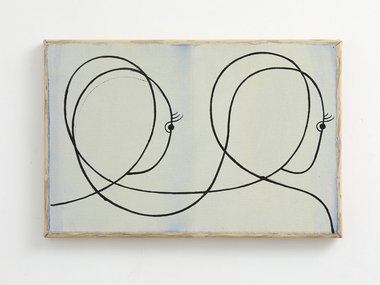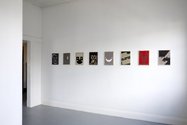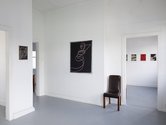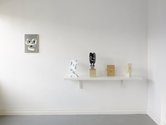John Hurrell – 25 May, 2019
The ‘simple pleasures' these abstract portraits provide via humour and compositional flair nudge us into pondering just what humanity (through its individuals) is and might be. They promote the delights of drawing and freefall imagination. Theatrical and design-conscious, they elevate the dynamics of facial recognition—using only a few arabesque components.
Looking at geometric signifiers for the basic elements of the face, and often using ribbonlike design motifs to express them, Julian Hooper in this gently amusing exhibition of small intimate paintings seems to be commenting on social interaction—and our primal responses to other humans when first encountered. Like stylised diagrammatic cartoons (in the manner of say Steinberg or Klee) these flowing cursive charts explore the possibilities of the human visage, being linear abstractions that test our ability to decipher multiple physiognomies.
The ‘simple pleasures’ these abstract portraits provide via humour and compositional flair nudge us into pondering just what humanity (through its individuals) is and might be. They promote the delights of drawing and freefall imagination. Theatrical and design-conscious, they elevate the dynamics of facial recognition—using only a few arabesque components.
The ‘ribbons’ allow a playful investigation of looped-through illusory space, and the primal subject-matter connects with advertising and contemporary products like car design, with their cunningly designed (attention-grabbing) faces made of headlights, radiator grilles and indicators. With very distinctive (but effective) irregular and asymmetrical ‘framing’, these stretchers are highly memorable.
There are also some stylised figure studies, torso and head, or shoulders and head, that are pretty successful. They could almost be nibbed quill drawings, or some kind of impeccable but flowing monoprint.
Alongside his wonderfully entertaining graphic paintings Hooper also presents a small group of related pastel-coloured ‘kitset’ sculptures, freestanding on a wall shelf, all presenting comical visages in 3D. Even more simple than the paintings, but quite lovely—with the greater complexity of twisted and ‘misaligned’ three dimensional configurations entwined into real space—these droll wooden sculptures (based on field guns) look like little ‘cut-out’ props on a stage. They are a clever extension of the paintings and just as witty; emphasising the planar, with the occasional oddly angled ‘tubular’ foil.
Hooper in this beautifully understated show makes the most of a kind of yuk-yuk goofy humour (a bit like Sean Kerr) but (like Kerr) beautifully executed. He makes you think about simple graphic signifiers for body parts, the importance of position and context, and how you mentally fill in the surrounding absent details—if so inclined.
John Hurrell



















 Two Rooms presents a program of residencies and projects
Two Rooms presents a program of residencies and projects Advertising in this column
Advertising in this column



This Discussion has 0 comments.
Comment
Participate
Register to Participate.
Sign in
Sign in to an existing account.